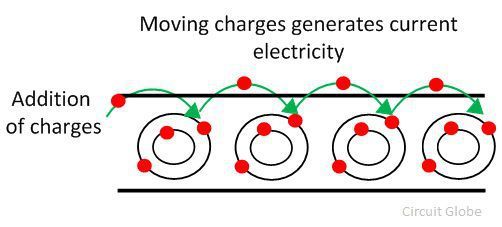The most significant difference between the static and current electricity is that in static electricity the charges are at rest and they are accumulating on the surface of the insulator. Whereas in current electricity the electrons are moving inside the conductor. The other differences between the static and current electricity are explained below in the comparison chart.
The static electricity uses in pollution control machine, in machine painting, xerography etc. The metallic plates of the pollution control machine convert the dirt particles into static charge. The static dirt particles attract towards the opposite charge plate of the pollution control machine. Thus, accumulate in the device. The current electricity use for performing the mechanical work like running the fan, motor, etc.
Content: Static Vs Current Electricity
Comparison Chart
| Basis for Comparison | Static Electricity | Current Electricity |
|---|---|---|
| Definition | The electricity which is build up on the surface of the substance is known as the static electricity. | The current electricity is because of the flow of electrons. |
| Causes | It induces because of the movement of the negative charges from one object to another | The current electricity is because of the movement of the electrons. |
| Material | The static electricity develops both in the conductor and insulator. | The current electricity develops only in conductor. |
| Magnetic Field | Not induces the magnetic field. | It induces magnetic field. |
| Time Period | Exist for short time. | Exists for long time. |
| Measuring Device | Gold leaf electroscope | Analog and digital meter. |
| Examples | Lightning strokes, it develop by rubbing the balloons on hair, etc. | The current electricity is used for running the fan, light, T.V etc. |
Definition of Static Electricity
The word static means not in moving condition. The electricity in which the charges remain at rest on the surface of the substance is called the static electricity. The static electricity generates by rubbing the two static objects.
Every object made of tiny particles called atoms. The atom consists the nucleus and free electrons. The nucleus has an equal number of neutrons and protons. The electrons of the atom move across their orbit. The free particles of some of the substance are weakly bounded.
While rubbing the two objects, the electrons having weak bond jump from one object to another. The objects which lose the electrons becomes positively charged. And the object which gains electrons becomes negatively charged. The potential develops between the static objects which cause the static electricity.
Consider the atoms of the hair and balloon. When we rubbed the balloon on hair, negative charges transfer between them. Let the negative charge moves from the atom of hair and adds on the atom of the balloon. Thus, the atoms of hairs become positively charged, and that of balloon becomes negatively charged.
The force of attraction induces between the hair and balloon. The positive and negative charges develop the potential difference between the hair and balloon. Thus the static electricity induces between them.
Definition of Current Electricity
The electricity which is produced because of the movement of electrons is known as the current electricity. It develops only on the material which has free electrons. The current electricity use for performing the mechanical works like for moving the fan, running the machine, etc. The magnetic field associates because of current electricity.
The AC (alternating current) and DC (direct current) are the types of current electricity. In alternating current, the charges flow in both the direction. And in direct current, the charges move only in one direction.
The substances made of tiny particles called the atom. The atom has the nucleus and electrons. The electrons move around the orbit of the atom, while the nucleus is fixed. The substances are of two types. The one which has the weakly bounded electrons and the other has strongly bounded electrons,
The substance having a weak bond between the electrons and an atom is called the conductor. When the external force likes voltage, thermal energy applies to it; the electrons become energised and start jumping from one atom to another inside the conductor. This movement of electrons generates the current electricity.
In nonmetals, the electrons are strongly bounded. But in metals, the electron jumps from one atom to another because of the repulsive property of charges. The movement of electrons generates the current electricity.
Key Differences between Static and Current Electricity
- The electricity in which charges remain static is known as the static electricity. Whereas, the current electricity develops because of flow of charges.
- The static electricity develops because of the movement of negative charges from one object to another. The current electricity is because of the movement of electrons in the atoms of the conductor.
- The static electricity develops on the surface of the insulator and conductor whereas the current electricity induces only in the conductor.
- The magnetic field develops because of the current electricity, and it doesn’t associate in the static electricity.
- The static electricity exits for a short time, whereas the current electricity exists for long periods.
- The gold leaf electroscope measures the magnitude of static electricity whereas the current electricity measures by the digital and analogue meter.
- The lightning strikes are the examples of the static electricity. The lightning strokes occur because the charge builds up on the surface of the cloud. The current electricity use for running the industrial machine and home appliances.
Conclusion
The static electricity is because of the charges at rest position. And the current electricity develops because of the movement of negative charges.



i like this it helped me a lot
I loved so much it helped a lot. Thxx
good info
It is very nice
Thanks it helped me a lot
Thanks! Greatly appreciated 😀
Thanks
It helped a lot, thanks🙌🙏
Helped a lot thanks